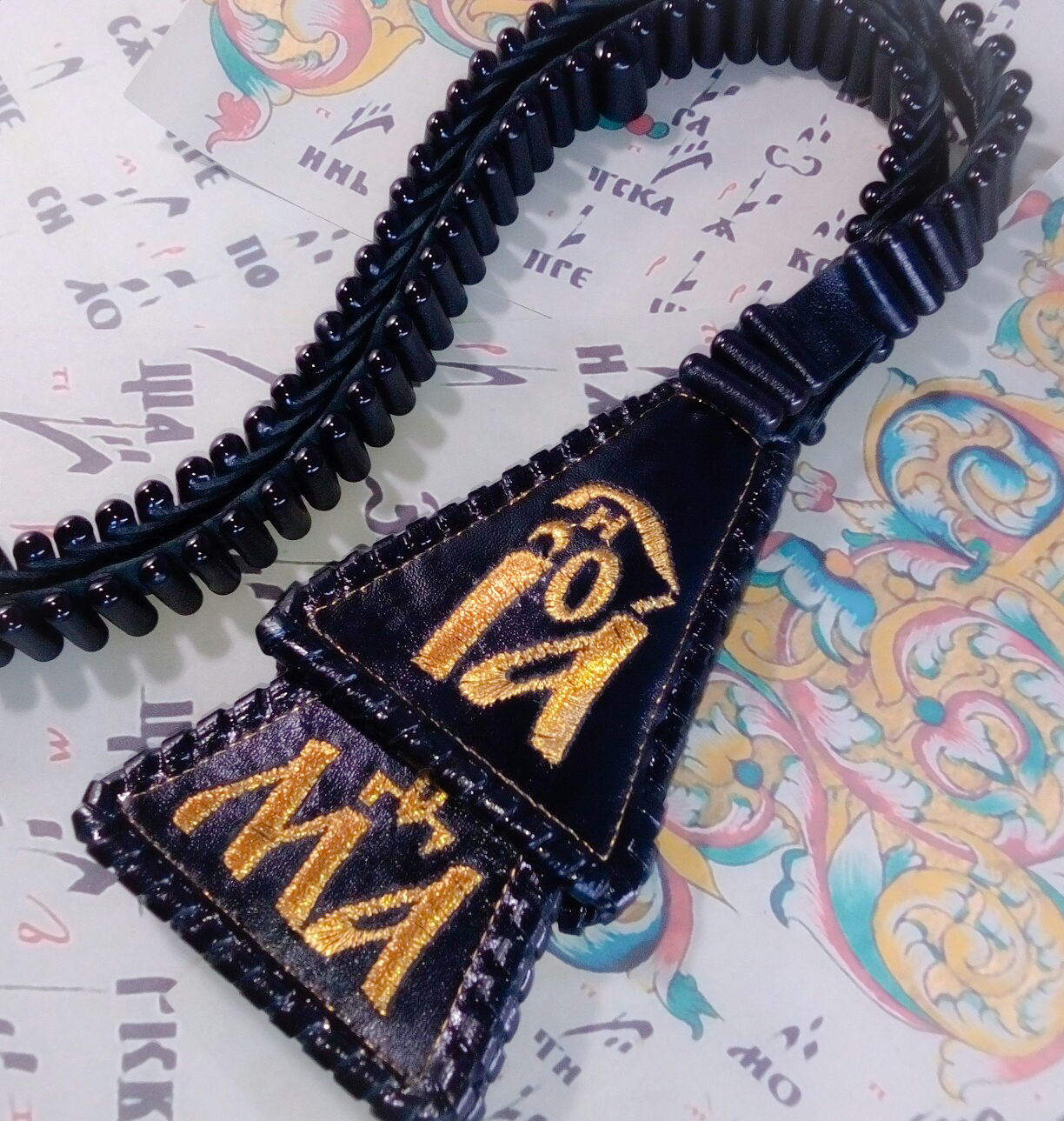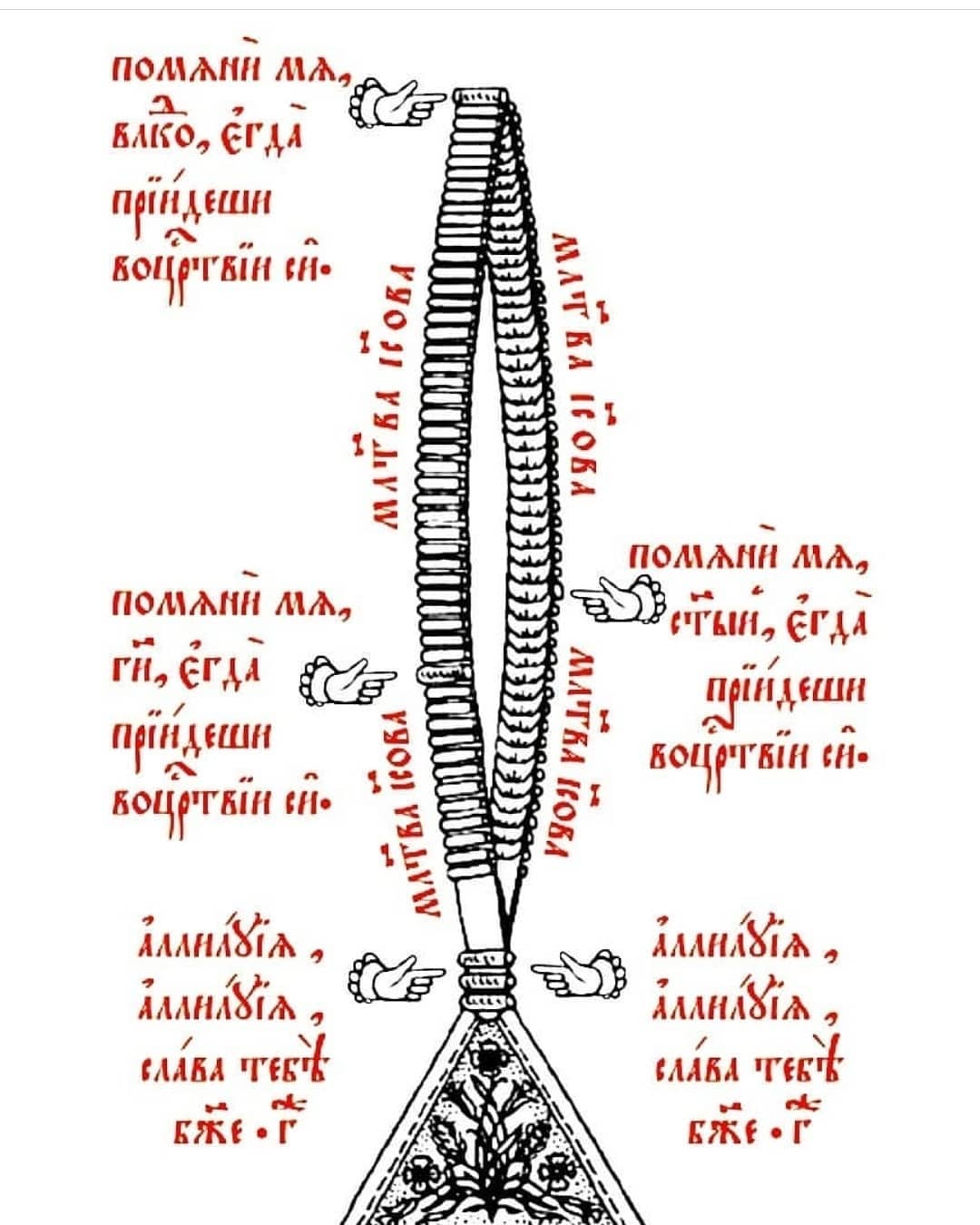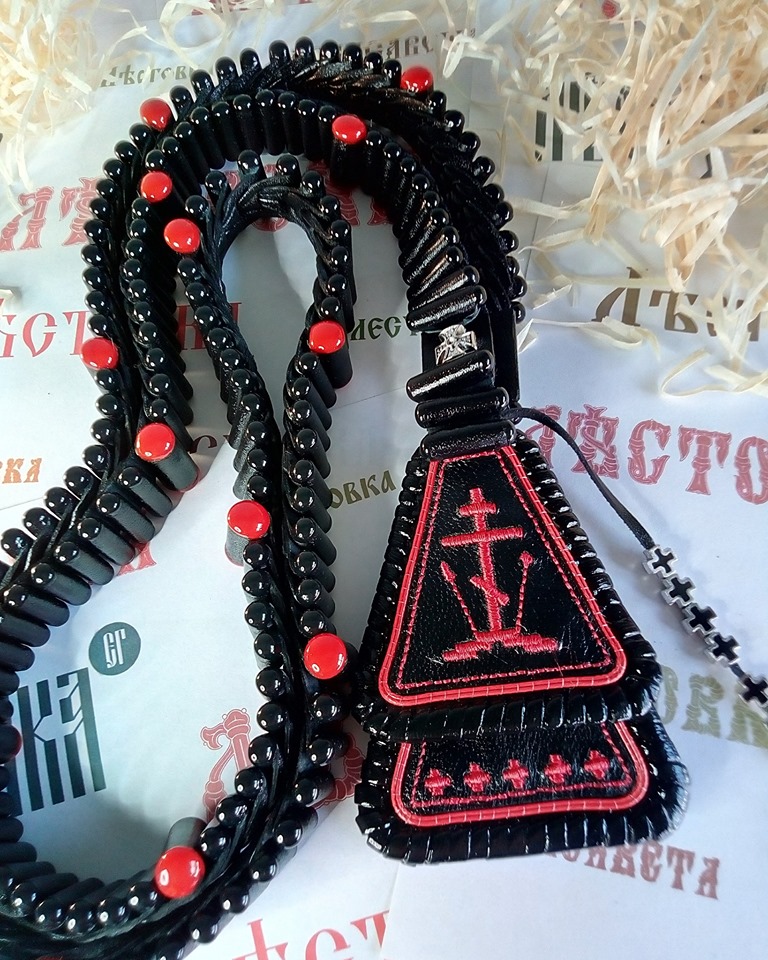Lestovka 1 on:
[Wikipedia]
[Google]
[Amazon]
 Lestovka (russian: –їe—Б—В–Њ–≤–Ї–∞) is a special type of
Lestovka (russian: –їe—Б—В–Њ–≤–Ї–∞) is a special type of
 Lestovka is often found outside communities that adhere to the liturgical practices of the Old Believers.
Lestovka is often found outside communities that adhere to the liturgical practices of the Old Believers.
About lestovka
{{in lang, pl, en Old Believer movement
Prayer beads
Christian prayer
Eastern Christian liturgical objects
Old Believer movement
Prayer beads
Christian prayer
Eastern Christian liturgical objects
 Lestovka (russian: –їe—Б—В–Њ–≤–Ї–∞) is a special type of
Lestovka (russian: –їe—Б—В–Њ–≤–Ї–∞) is a special type of prayer rope
A prayer rope gr, ќЇќњќЉѕАќњѕГќЇќњќѓќљќє ''komboskini''; russian: —З—С—В–Ї–Є ''chotki'' (most common term) or ''vervitsa'' (literal translation); ar, ўЕЎ≥Ў®Ў≠Ў©, misbaбЄ•a; Romanian: ''metanii / metanier''; Serbian and Macedonian: –±—А–Њ—Ш–∞–љ–Є ...
made of leather, once in general use in old Russia, and is still used by Russian Old Believers today, such as the Russian Orthodox Christians and Russian Orthodox Oldritualist Church, Pomorian Old-Orthodox Church
The Pomorian Old Orthodox Church ( rus, –Ф—А–µ–≤–ї–µ–њ—А–∞–≤–Њ—Б–ї–∞–≤–љ–∞—П –њ–Њ–Љ–Њ—А—Б–Ї–∞—П —Ж–µ—А–Ї–Њ–≤—М, Drevlepravoslavnaya pomorskaya tserkov), also known as the Pomorian Church, Danilovtsy, Danilov's confession, or simply as Pomorians, i ...
and edinoverians.
Form and symbolism
The Lestovka is traditionally constructed of leather, with "steps" made by looping leather around small twigs sections on which paper scrolls with Jesus prayer are wound. It has a total of 109 "steps" вАУ small loops or knots, unevenly grouped: 3/12/38/33/17/3 steps. Traditionally, Lestovki are made from genuine leather, but poorer people make Lestovki from fabric or other materials. At the bottom of the lestovka hang four ''lapostki'', which are flaps, usually triangular, but such variations as bell or oak-leaf shapes are not uncommon. These represent the fourGospels
Gospel originally meant the Christian message ("the gospel"), but in the 2nd century it came to be used also for the books in which the message was set out. In this sense a gospel can be defined as a loose-knit, episodic narrative of the words an ...
, and sometimes have icons, crosses, religious symbols or scripture verses printed or stitched on them, the stitching around these leaves symbolising the teaching of the Gospels. Simpler lestovkas will have the lapostki covered with silk
Silk is a natural protein fiber, some forms of which can be woven into textiles. The protein fiber of silk is composed mainly of fibroin and is produced by certain insect larvae to form cocoons. The best-known silk is obtained from the coc ...
brocade
Brocade is a class of richly decorative shuttle-woven fabrics, often made in colored silks and sometimes with gold and silver threads. The name, related to the same root as the word "broccoli", comes from Italian ''broccato'' meaning "embos ...
or velvet
Weave details visible on a purple-colored velvet fabric
Velvet is a type of woven tufted fabric in which the cut threads are evenly distributed, with a short pile, giving it a distinctive soft feel. By extension, the word ''velvety'' means ...
, and this is a traditional way of reusing church fabrics, either of vestments
Vestments are liturgical garments and articles associated primarily with the Christian religion, especially by Eastern Churches, Catholics (of all rites), Anglicans, and Lutherans. Many other groups also make use of liturgical garments; this ...
that have become too worn out for clergy to wear, or of altar-coverings and similar fabrics.
Near these lapostki are seven small movable pieces. They are called peredvizki. Some masters make them in the form of 7 crosses or beads. These seven pieces represent the seven Mysteries (Sacraments) of the Church, their location near the leaves of the lapostki indicating their origin in and central relation to the Gospels.
In the Old Believer tradition, seven small moving parts are made invisible. But especially skilled craftsmen make them with an elevator system - they can be extended and then put back in place.
Next, the main loop will have three large ''steps'' on either side where it joins the lapostki (in lestovkas that are joined together), and on the Lestovka itself are three more large ''steps'', giving a total of nine, representing the nine months in which Christ
Jesus, likely from he, „Щ÷µ„©„Б„Х÷Љ„Ґ÷Ј, translit=YƒУ≈°≈Ђa њ, label=Hebrew/Aramaic ( AD 30 or 33), also referred to as Jesus Christ or Jesus of Nazareth (among other Names and titles of Jesus in the New Testament, names and titles), was ...
was in the womb of the Theotokos
''Theotokos'' (Greek: ) is a title of Mary, mother of Jesus, used especially in Eastern Christianity. The usual Latin translations are ''Dei Genitrix'' or ''Deipara'' (approximately "parent (fem.) of God"). Familiar English translations are " ...
(Blessed Virgin Mary
Mary; arc, №°№™№Э№°, translit=Mariam; ar, ўЕЎ±ўКўЕ, translit=Maryam; grc, ќЬќ±ѕБќѓќ±, translit=Mar√≠a; la, Maria; cop, в≤Шв≤Бв≤£в≤Ув≤Б, translit=Maria was a first-century Jews, Jewish woman of Nazareth, the wife of Saint Joseph, Jose ...
), and also for the nine choirs of angels
In various theistic religious traditions an angel is a supernatural spiritual being who serves God.
Abrahamic religions often depict angels as benevolent celestial intermediaries between God (or Heaven) and humanity. Other roles incl ...
.
After the three large ''steps'' on either side is a space, representing the heavens and the earth.
Coming to the main set of counters, one finds twelve small ''babochki'' (rungs, steps), signifying the Twelve Apostles
In Christian theology and ecclesiology, the apostles, particularly the Twelve Apostles (also known as the Twelve Disciples or simply the Twelve), were the primary disciples of Jesus according to the New Testament. During the life and minist ...
. Then are thirty-eight small counters, representing the thirty-six weeks and two days during which the Theotokos carried Christ in her womb. Next, thirty-three small counters for the number of years Christ lived on earth, followed by seventeen small counters for the seventeen Old Testament
The Old Testament (often abbreviated OT) is the first division of the Christian biblical canon, which is based primarily upon the 24 books of the Hebrew Bible or Tanakh, a collection of ancient religious Hebrew writings by the Israelites. The ...
prophets plus St John the Baptist
John the Baptist or , , or , ;Wetterau, Bruce. ''World history''. New York: Henry Holt and Company. 1994. syc, №Э№Ш№њ№Ъ№≤№Ґ№µ№Ґ №°№≤№•№°№ХЁВ№µ№Ґ№µ№Р, YoбЄ•anƒБn Ma њmбЄПƒБnƒБ; he, „Щ„Х„Ч„†„Я „Ф„Ю„Ш„С„Щ„Ь, YohanƒБn HaMatbil; la, Ioannes Bapti ...
who prophesied about the coming of Christ.
Usage
If one is unable to attend services in church for whatever reasons, it is considered commendable to pray on the lestovka, using a number of repetitions of theJesus prayer
The Jesus Prayer,; syr, №®№†№Ш№ђ№Р №Х№Э№Ђ№Ш№•, translit=slotho d-yeshu'; syr, label= Amharic, Geez and Tigrinya, бК•бМНбЛЪбК¶ бИШбИРбИ®бКР бК≠бИ≠бИµбЙґбИµ, translit=igizi'o meбЄ•arene kirisitosi. "Note: We are still searching the Fathers for ...
combined with specific bows and prostrations
Prostration is the gesture of placing one's body in a reverentially or submissively prone position. Typically prostration is distinguished from the lesser acts of bowing or kneeling by involving a part of the body above the knee, especially ...
.
When using the lestovka as part of a rule of prayer, the three counters at either end are used for the following prayers (accompanied by bows) at the end and beginning of the prayer session:
:–С–Њ–ґ–µ, –Љ–Є–ї–Њ—Б—В–Є–≤—К –±—є–і–Є –Љ–љ–µ –≥—А—£—И–љ–Њ–Љ—є. (–≥—А—£—И–љ—£–є if one is female)
:–°–Њ–Ј–і–∞–≤–Є –Љ—І, –У–Њ—Б–њ–Њ–і–Є, –њ–Њ–Љ–Є–ї—є–є –Љ—І.
:–С–µ–Ј—К —З–Є—Б–ї–∞ —Б–Њ–≥—А—£—И–Є—Е—К, –У–Њ—Б–њ–Њ–і–Є, –њ—А–Њ—Б—В–Є –Љ—І.
::God be merciful to me a sinner. (''bow'')
::Thou hast created me; Lord, have mercy on me. (''bow'')
::I have sinned immeasurably; Lord, forgive me. (''bow'')
:Some say, at the last line, "–њ–Њ–Љ–Є–ї—є–є –Є –њ—А–Њ—Б—В–Є –Љ—І –≥—А—£—И–љ–∞–≥–Њ/–≥—А—£—И–љ—є—О" (have mercy and forgive me a sinner) instead of "–њ—А–Њ—Б—В–Є –Љ—І" (forgive me).
The remaining one hundred small counters are used for the repetition of the Jesus prayer
The Jesus Prayer,; syr, №®№†№Ш№ђ№Р №Х№Э№Ђ№Ш№•, translit=slotho d-yeshu'; syr, label= Amharic, Geez and Tigrinya, бК•бМНбЛЪбК¶ бИШбИРбИ®бКР бК≠бИ≠бИµбЙґбИµ, translit=igizi'o meбЄ•arene kirisitosi. "Note: We are still searching the Fathers for ...
, with bows and prostrations.
Other uses of the lestovka include counting the twelve or forty repetitions of Lord have mercy used as responses at the Divine Liturgy
Divine Liturgy ( grc-gre, ќШќµќѓќ± ќЫќµќєѕДќњѕЕѕБќ≥ќѓќ±, Theia Leitourgia) or Holy Liturgy is the Eucharistic service of the Byzantine Rite, developed from the Antiochene Rite of Christian liturgy which is that of the Ecumenical Patriarchate of C ...
and Canonical hours
In the practice of Christianity, canonical hours mark the divisions of the day in terms of fixed times of prayer at regular intervals. A book of hours, chiefly a breviary, normally contains a version of, or selection from, such prayers.
In ...
. The seventeen counters are also used to count the number of bows during the Prayer of Saint Ephrem
"The Prayer of Saint Ephrem" (Greek: , ''Efch√≠ to√Ї Os√≠ou Efrem''), is a prayer attributed to Saint Ephrem the Syrian and used during the Great Lent by the Eastern Orthodox and Byzantine Catholic Churches. In the Byzantine tradition, this prayer ...
.
Lestovka with 150 steps is used to read prayers to the Virgin Mary.
Outside of Old Belief
 Lestovka is often found outside communities that adhere to the liturgical practices of the Old Believers.
Lestovka is often found outside communities that adhere to the liturgical practices of the Old Believers. Eastern Catholic
The Eastern Catholic Churches or Oriental Catholic Churches, also called the Eastern-Rite Catholic Churches, Eastern Rite Catholicism, or simply the Eastern Churches, are 23 Eastern Christian autonomous ('' sui iuris'') particular churches of t ...
and Eastern Orthodox
Eastern Orthodoxy, also known as Eastern Orthodox Christianity, is one of the three main branches of Chalcedonian Christianity, alongside Catholicism and Protestantism.
Like the Pentarchy of the first millennium, the mainstream (or "canonical") ...
Christians who are knowledgeable about Slavic traditions of the Byzantine rite love to own and use them. Members of the Russian Orthodox Church
, native_name_lang = ru
, image = Moscow July 2011-7a.jpg
, imagewidth =
, alt =
, caption = Cathedral of Christ the Saviour in Moscow, Russia
, abbreviation = ROC
, type ...
today are increasingly using lestovka. Examples of Russian Orthodox saints depicted with a staircase are Seraphim of Sarov
Seraphim of Sarov (russian: –°–µ—А–∞—Д–Є–Љ –°–∞—А–Њ–≤—Б–Ї–Є–є; вАУ ), born Pr√≥khor Is√≠dorovich Moshn√≠n (Mashn√≠n) Я—А–ЊћБ—Е–Њ—А –Ш—Б–ЄћБ–і–Њ—А–Њ–≤–Є—З –Ь–Њ—И–љ–ЄћБ–љ (–Ь–∞—И–љ–ЄћБ–љ) is one of the most renowned Russian saints and is venerate ...
,Sergius of Radonezh
Sergius of Radonezh (russian: –°–µћБ—А–≥–Є–є –†–∞ћБ–і–Њ–љ–µ–ґ—Б–Ї–Є–є, ''Sergii Radonezhsky''; 14 May 1314 вАУ 25 September 1392), also known as Sergiy Radonezhsky, Serge of Radonezh and Sergius of Moscow, was a spiritual leader and monastic re ...
, Kiev Pechersk Saints and many other saints of the Russian Orthodox Church.
Sources and references
*–Т—Г—А–≥–∞—Д—В –°.–У., –£—И–∞–Ї–Њ–≤ –Ш.–Р. ''–°—В–∞—А–Њ–Њ–±—А—П–і—З–µ—Б—В–≤–Њ. –Ы–Є—Ж–∞, —Б–Њ–±—Л—В–Є—П, –њ—А–µ–і–Љ–µ—В—Л –Є —Б–Є–Љ–≤–Њ–ї—Л. –Ю–њ—Л—В —Н–љ—Ж–Є–Ї–ї–Њ–њ–µ–і–Є—З–µ—Б–Ї–Њ–≥–Њ —Б–ї–Њ–≤–∞—А—П'', –Ь–Њ—Б–Ї–≤–∞ 1996 (Vurgaft S.G., U≈°akov I.A. ''Old Believers. Persons, Events, Objects and Symbols. Attempt to an Encyclopedian Dictionary.'' Moscow, 1996)See also
* Russian Orthodox Oldritualist Church * Old Believers * HesychasmExternal links
About lestovka
{{in lang, pl, en
 Old Believer movement
Prayer beads
Christian prayer
Eastern Christian liturgical objects
Old Believer movement
Prayer beads
Christian prayer
Eastern Christian liturgical objects